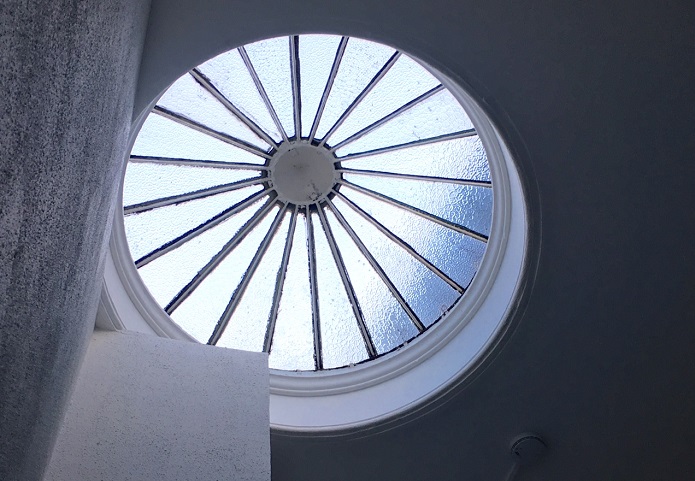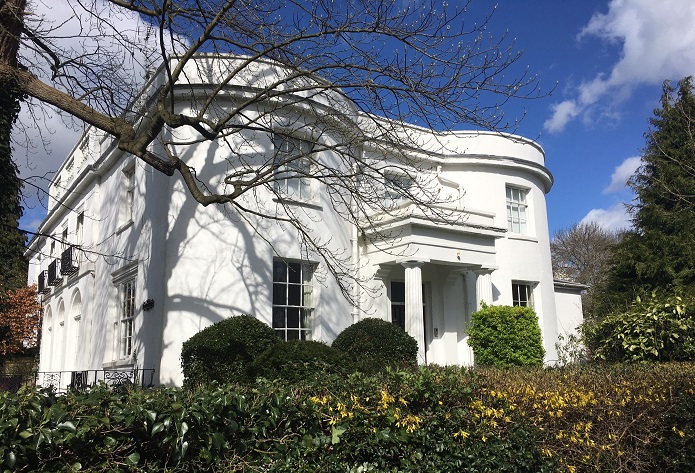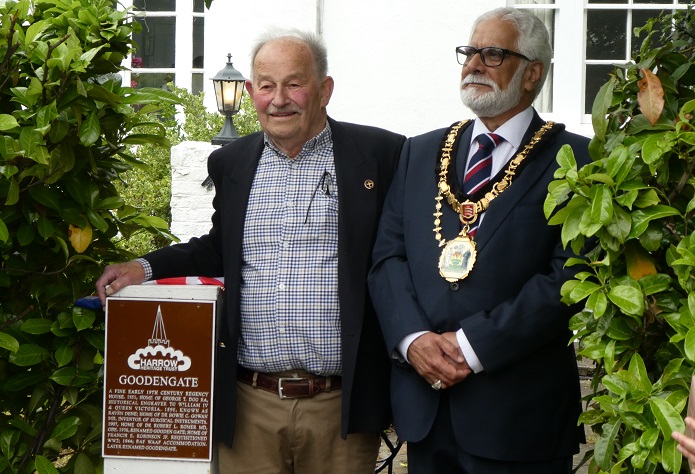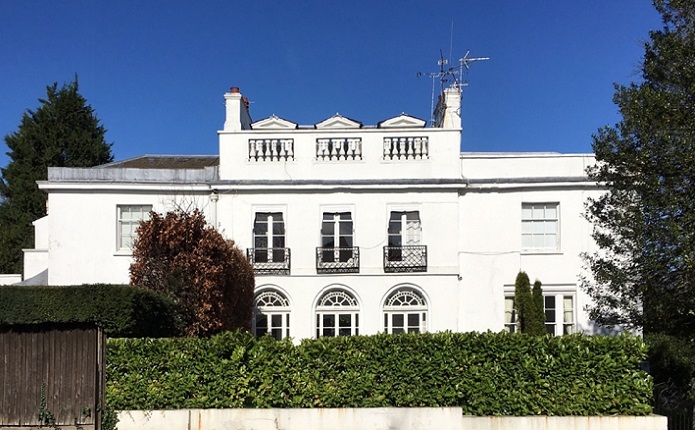In December 1888 the British textile designer William Morris, visited Stanmore to redesign the interior of Stanmore Hall, he described the countryside around Stanmore Hill as "up and down and much beset with gentleman’s houses" well, Goodengate or Raven Dene as it was called back then would certainly have fitted neatly into that category.
Located at 42-44 Stanmore Hill on the corner of Stangate Gardens, is this spectacular grade II listed building, and a wonderful example of Regency architecture. The property was built around 1812, and like many erected in this style has an impressive white painted Stucco façade with a large central porch and an entryway framed by two fluted Doric columns.
On the west side, key decorative elements include the fanlights to ground floor windows, and elegant wrought iron balconies underneath the three central windows at first floor, with timber boards in front of the French windows, both iron balconies and bow windows came into architectural fashion as part of this style of building. The house still retains many period features, including an early Regency staircase leading from the communal entrance hall. Another interesting original feature is a skylight on the first-floor landing in the style of Sir John Soane. Soane’s inventive use of light, space and his experimentation with natural lighting was another aspect that was to become fashionable, in the world of Classical architecture.
As well as a spectacular exterior, the house has been home to a number of renowned residents including George Thomas Doo, who with his wife Caroline, moved to Stanmore sometime between 1836-1847.
George Thomas Doo RA FRS
Doo was a celebrated engraver and generally considered to be top of his game in the world of engraving. Trained in Paris he became engraver-in-ordinary to William IV in 1836, and later in 1842 to Queen Victoria. He became a Fellow of the Royal Society in 1851, and elected a member of the Royal Academy in 1857. Generally considered his finest engraving, The Raising of Lazarus, after S. del. Piombo, took 8 years to complete. During his time in Stanmore, Doo took an active interest in the community and was a participant in the Vestry meetings of the Parish Council.
George left Stanmore in 1871, he moved to Surrey and died in 1886 at his home, his body was brought back to Stanmore where he is buried alongside his daughter in the graveyard of St. Johns.

Image courtesy of Laura Dubiner
Dr Bowie Campbell Gowan
Another resident of Ravens Dene was Dr Bowie Campbell Gowan, who came to Stanmore with his family in 1890. Gowan worked locally both in Stanmore and Harrow Weald and held several positions as a physician and Medical Officer. He was Public Vaccinator to the Harrow Weald & Stanmore District Hendon Union, Medical Officer of Health of the Hendon Rural District Council and Medical Officer to the Stanmore Isolation Hospital.
The health of Dr Gowan's wife Leila started to deteriorate, so he resigned as Medical Officer of Health to the Hendon Rural District Council and in 1907 left Stanmore to retire to Bournemouth.
The Gowans were so well thought of locally that their friends, patients, colleagues and neighbours had a whip-round for him as a leaving present, which was presented to him on Christmas morning 1906, a staggering amount was raised which totalled 100 Guinea’s, notable contributors were his landlord and owner of Stanmore Hall, William Knox D’Arcy and W.S. Gilbert of Gilbert and Sullivan fame, who owned Grim’s Dyke.

Image courtesy of Laura Dubiner
Dr Robert Leslie Romer OBE
The next resident was Dr Robert Leslie Romer, who took over from where Dr Gowan left off both in respect of the house and his work. Another medical professional with a top-class pedigree, Romer was registered as a Member of the Royal College of Surgeons, the Licentiate of the Royal College of Physicians and Licentiateship Society of Apothecaries. He studied at Cambridge University and St. George’s Hospital,
In 1907, Dr Romer succeeded Dr Gowan, his practice partner to the position of medical officer to the Hendon Rural District Council. A post he held until 1934. He also took over all of Dr Gowan’s responsibilities, including work at the Stanmore Isolation Hospital and Public Vaccinator.
During the Great War, Dr Romer worked at the Brockley Hill Hospital & Soldiers’ Hospital at Aldenham. On two occasions he served on a hospital ship in the Mediterranean and the Channel. In recognition for his work, he was awarded an O.B.E in 1920. Dr Romer lived at Raven Dene until 1930, when he moved to “Park Spinney”, The Chase, Stanmore. When he passed away in 1935, he was buried at St. Johns.
Francis Edward Robinson JP & Amy Robinson
The next residents of Raven Dene were Francis and Amy Robinson and it seems that the Robinsons were instrumental in the house being renamed from Ravens Dene to Gooden Gate. For the five years before moving to Stanmore Hill Francis, Amy & family lived at Gooden Gate in Marsh Lane, which they named after a small village near Hopwood Lancashire, a place which the Robinsons had family connections with.
Both Francis and Amy did a lot of work for Stanmore and its people both professionally and voluntary, Frances was a member of Middlesex County Council, representing the Pinner Division, which included Great Stanmore & Little Stanmore. Francis was appointed a Justice of the Peace in 1916; later to become Deputy Chairman of the Justices for the Gore Division of Middlesex. In later years becoming manager of Stanmore Church of England Schools, and honorary Secretary of the Stanmore Conservative Association. Recreationally Robison took a keen interest in sport, becoming, Vice President of the Stanmore Village Cricket Club and the first president of The Elms Club in Church Road. Amy too also was a great champion of local causes, from time to time helping at the Royal National Orthopaedic Hospital. Both Amy and Francis lived at Goodengate for the rest of their lives and are buried in the churchyard of St. John the Evangelist, Stanmore.
During World War II many properties in Stanmore and neighbouring areas, were requisitioned by the Air Ministry to billet the ever-growing staff at the Bentley Priory and Stanmore Park bases. July 1944, saw Goodengate taken over by the RAF, for members of the Allied Expeditionary Air Force, and the Women’s Auxiliary Air Force who worked in the Filter room at nearby Bentley Priory.
After the war ended the house found its way into the care of Harrow Council. It was agreed that the property would be split into flats and sold off. Goodengate is a fine example of a recency style property, so in 1980 its owners applied for an ’Historic Building Grant ’ and was awarded a grant to help with the costs of renovation. In 2020 its owners applied to Harrow Council for a heritage plaque.

Harrow Heritage Plaque
The Mayor of Harrow unveiled a brown Harrow heritage plaque on the house to detail the property’s historic past, on 19 June 2021 at a small ceremony planned to mark the event.
Also in attendance was local MP Bob Blackman who was quoted as saying " I was pleased to be able to attend the unveiling Harrow Heritage plaque at the Goodengate house in Stanmore Hill. It was great to be joined by the new Mayor of Harrow as well as Stanmore Park councillors Philip Benjamin and Camilla Bath. It’s very important we celebrate our local history, so I am delighted that this house, home to several notable figures and a piece of WWII history, now has this plaque in recognition. "
The inscription reads, Goodengate, fine early 19th Century regency house. 1851, home of George T Doo RA. historical engraver to William IV and Queen Victoria. 1890, known as Raven Dene; home of Doctor Bowie C. Gowan MD, inventor of surgical instruments. 1907, home of Doctor L Romer MD, OBE. 1930, renamed Gooden Gate; home of Francis E. Robinson JP. Requisitioned WWII; 1944, RAF WAAF accommodation, Later renamed Goodengate.
Source: Goodengate: House History, author Sharon Ward, October 2020.
